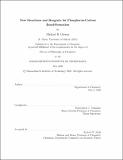New reactions and reagents for phosphorus-carbon bond-formation
Author(s)
Geeson, Michael B.
Download1192965220-MIT.pdf (41.22Mb)
Other Contributors
Massachusetts Institute of Technology. Department of Chemistry.
Advisor
Christopher C. Cummins.
Terms of use
Metadata
Show full item recordAbstract
Chapter 1 takes the format of an "Outlook", and sets forth the case for developing sustainable methods in the synthesis of phosphorus-containing compounds. Methods used by nature for phosphorus-carbon bond-formation, or in the chemistry of other elements such as silicon, are discussed as model processes for the future of phosphorus in chemical synthesis. Chapter 2 describes the discovery of [TBA][P(SiCl₃)₂], prepared from [TBA]₃[P₃O₉]-.2H₂O and trichlorosilane. The bis(trichlorosilyl)phosphide anion is used to prepare compounds that contain P-C, P-O, P-F, and P-H bonds in a method that bypasses white phosphorus (P₄), the traditional route to organophosphorus compounds. Chapter 3 extends the phosphate precursors to [TBA][P(SiCl₃)₂] from trimetaphosphate to crystalline phosphoric acid. Balanced equations are developed for the formation of [TBA][P(SiCl₃)₂] from phosphate sources and the byproducts are identified as hexachlorodisiloxane and hydrogen gas. Extension of trichlorosilane reduction to bisulfate provides improved access the known trichlorosilylsulfide anion, [TBA][SSiCl₃]. This anion was used as a thionation reagent to prepare thiobenzophenone and benzyl mercaptan from benzophenone and benzyl bromide, respectively. Chapter 4 describes the synthesis of neutral phosphine, HP(SiCl₃)₂, obtained by protonation of [TBA]1 with triflic acid. HP(SiCl₃)₂ is a highly efficient reagent for photochemical hydrophosphination of terminal alkenes. The phosphorus-silicon bonds in the hydrophosphination products can be functionalized to provide compounds of the general formulae: RPCl₂, RPH₂, [RP(R')₃]Cl, RP(O)(H)(OH), and RP(O)(OH)₂. Chapter 5 describes a method to prepare phosphiranes (three-membered rings that contain a phosphorus atom) from anthracene-based phosphinidene precursors and styrenic olefins. The phosphinidene transfer reaction requires an organoiron and fluoride catalyst. The resulting phosphirane is prepared in good yield (73%) with high stereoselectivity (>99%). Experimental investigations into the mechanism point toward the intermediacy of an iron-coordinated fluorophosphide species.
Description
Thesis: Ph. D., Massachusetts Institute of Technology, Department of Chemistry, May, 2020 Cataloged from the official PDF of thesis. Page 373 blank. Includes bibliographical references.
Date issued
2020Department
Massachusetts Institute of Technology. Department of ChemistryPublisher
Massachusetts Institute of Technology
Keywords
Chemistry.